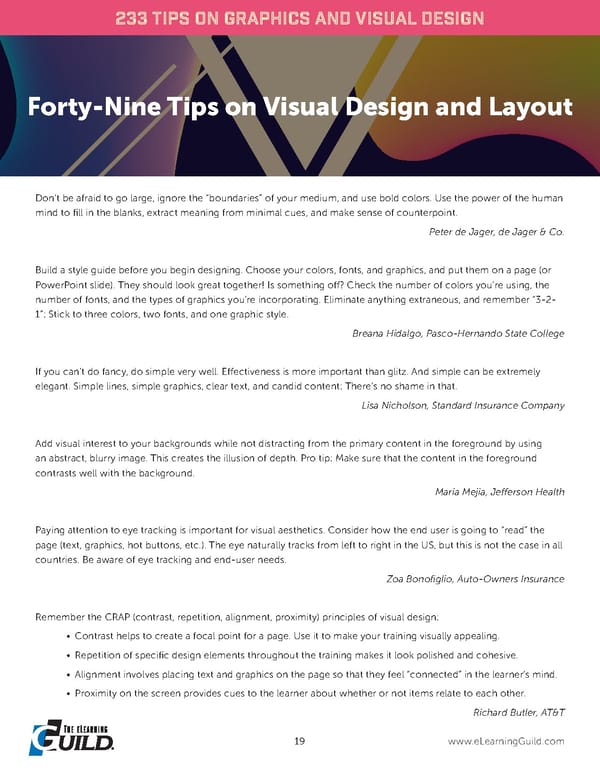233 TIPS Graphics and Visu De al sign 233 TIPS ON GRAPHICS AND VISUAL DESIGN Forty-Nine Tips on Visual Design and Layout Don’t be afraid to go large, ignore the “boundaries” of your medium, and use bold colors. Use the power of the human mind to fill in the blanks, extract meaning from minimal cues, and make sense of counterpoint. Peter de Jager, de Jager & Co. Build a style guide before you begin designing. Choose your colors, fonts, and graphics, and put them on a page (or PowerPoint slide). They should look great together! Is something off? Check the number of colors you’re using, the number of fonts, and the types of graphics you’re incorporating. Eliminate anything extraneous, and remember “3-2- 1”: Stick to three colors, two fonts, and one graphic style. Breana Hidalgo, Pasco-Hernando State College If you can’t do fancy, do simple very well. Effectiveness is more important than glitz. And simple can be extremely elegant. Simple lines, simple graphics, clear text, and candid content: There’s no shame in that. Lisa Nicholson, Standard Insurance Company Add visual interest to your backgrounds while not distracting from the primary content in the foreground by using an abstract, blurry image. This creates the illusion of depth. Pro tip: Make sure that the content in the foreground contrasts well with the background. Maria Mejia, Jefferson Health Paying attention to eye tracking is important for visual aesthetics. Consider how the end user is going to “read” the page (text, graphics, hot buttons, etc.). The eye naturally tracks from left to right in the US, but this is not the case in all countries. Be aware of eye tracking and end-user needs. Zoa Bonofiglio, Auto-Owners Insurance Remember the CRAP (contrast, repetition, alignment, proximity) principles of visual design: • Contrast helps to create a focal point for a page. Use it to make your training visually appealing. • Repetition of specific design elements throughout the training makes it look polished and cohesive. • Alignment involves placing text and graphics on the page so that they feel “connected” in the learner’s mind. • Proximity on the screen provides cues to the learner about whether or not items relate to each other. Richard Butler, AT&T 19 www.eLearningGuild.com
 233 Tips on Graphics and Visual Design Page 21 Page 23
233 Tips on Graphics and Visual Design Page 21 Page 23